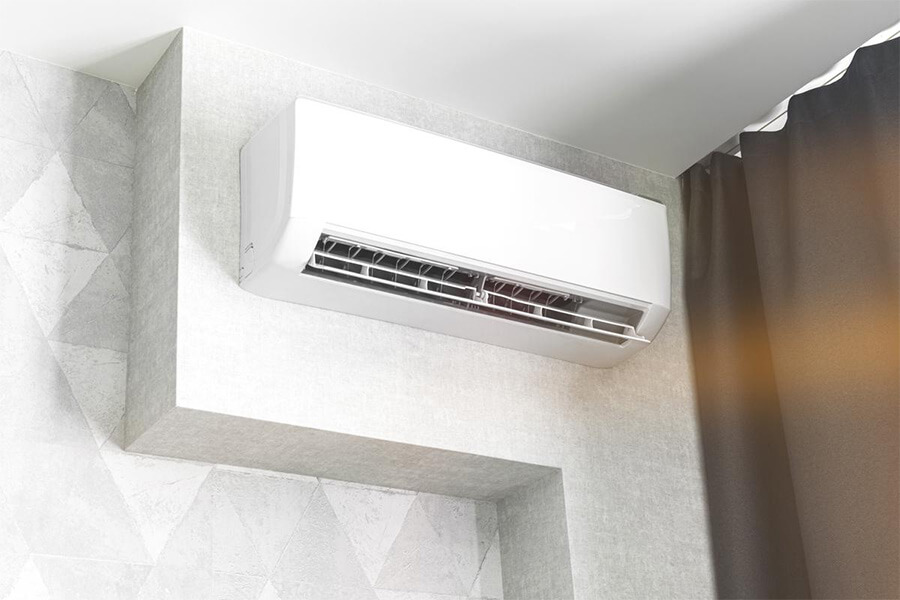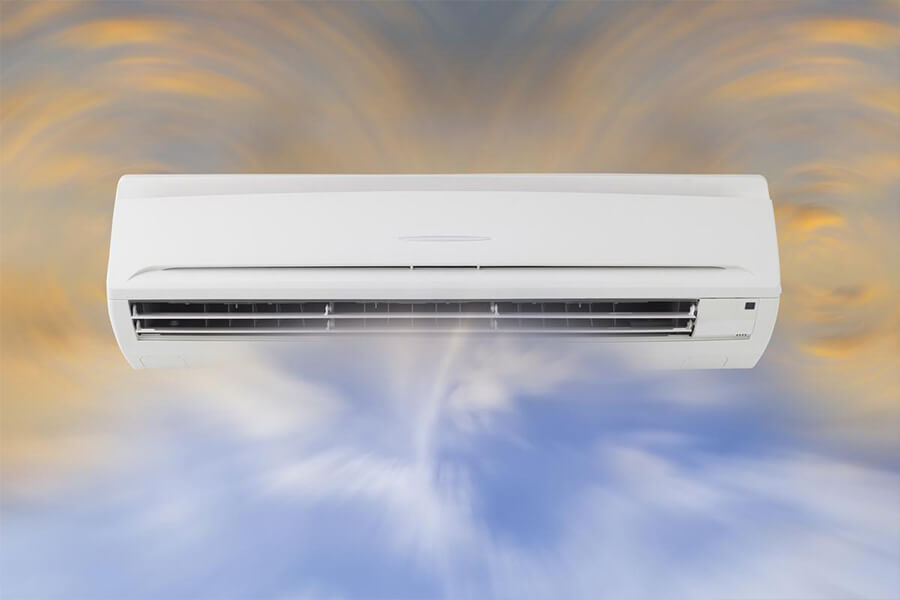Introduction
A mini split, also known as a ductless mini split or ductless heating, ventilation, and air conditioning (HVAC) system, provides efficient and targeted climate control for individual rooms or zones within a building. It offers a flexible and energy-efficient alternative to traditional central HVAC systems that use ducts to distribute air throughout a structure. Mini split systems are made up of an outside condenser unit and one or more inside air-handling units that are linked together via refrigerant lines and electrical connections. These systems have gained popularity for their versatility, ease of installation, and energy-saving features.
Mini Split System
 A mini split system uses the refrigeration cycle to move heat from inside regions to the outdoors, operating on the same fundamental principles as a standard air conditioning system. Mini split systems, on the other hand, offer a number of unique advantages due to differences in design and installation.
A mini split system uses the refrigeration cycle to move heat from inside regions to the outdoors, operating on the same fundamental principles as a standard air conditioning system. Mini split systems, on the other hand, offer a number of unique advantages due to differences in design and installation.
Components Of Mini-split System
The main components of a mini split system include:
- Outdoor Condenser Unit: This unit houses the compressor, condenser coil, and fan. It’s responsible for releasing heat absorbed from the indoor spaces to the outside environment.
- Indoor Air-Handling Units (AHUs): These are installed in the rooms or zones you want to condition. AHUs contain an evaporator coil, a fan, and air filters. They deliver cooled or heated air directly into the space.
- Refrigerant Lines: The outdoor unit is connected to the indoor units by copper tubing or other refrigerant connections. These lines carry the refrigerant, which transfers heat via cycling between the indoor and outdoor units.
- Control System: Mini split systems come with remote controls, wall-mounted thermostats, or even smartphone apps, allowing users to set the desired temperature and control various settings for each indoor unit independently.
Types Of Mini Split Systems
- Single-Zone Mini Splits: In single-zone systems, a single outdoor unit is connected to a single indoor unit, providing heating and cooling to a specific room or area.
- Multi-Zone Mini Splits: Multi-zone systems have one outdoor unit connected to multiple indoor units. Each indoor unit can be individually controlled, enabling the conditioning of various rooms or zones according to personal preferences.
Advantages Of Mini Split Systems
 Energy Efficiency: Mini split systems offer high energy efficiency because they can cool or heat only the areas that require it. Duct losses common in central HVAC systems are eliminated, resulting in reduced energy consumption.
Energy Efficiency: Mini split systems offer high energy efficiency because they can cool or heat only the areas that require it. Duct losses common in central HVAC systems are eliminated, resulting in reduced energy consumption.
- Zoned Comfort: Multi-zone systems provide personalized comfort for different areas, as each indoor unit can be set to its own temperature and operating mode. This prevents over-conditioning of unoccupied spaces.
- Easy Installation: Mini split systems are relatively easier to install than traditional HVAC systems. They don’t require ductwork, which can be expensive and complex to install in existing structures.
- Flexibility: These systems are suitable for various applications, such as homes, apartments, offices, server rooms, etc. They can be installed in locations where ductwork is impractical.
- Improved Indoor Air Quality: Mini split systems frequently come with air filters that reduce indoor air pollution by removing dust, allergies, and other particles from the air.Quiet Operation: The indoor units of mini split systems are generally quieter than traditional HVAC systems because the loud components, like the compressor and condenser fan, are outdoors.
- Zonal Control: By conditioning only the areas that are occupied, users of zonal temperature control can save energy by avoiding the need to heat or cool the entire building.
- Aesthetics: The indoor units of mini split systems are often sleek and unobtrusive, blending into the décor of the room more seamlessly than large ducted vents.
Installation Process Of A Ductless Mini Split System
The installation of a mini split system involves several key steps:
- Unit Placement: Indoor units are strategically mounted on walls, ceilings, or floors in the rooms to be conditioned. Outdoor units are typically placed on a solid surface outdoors.
- Refrigerant Lines and Wiring: Refrigerant lines and electrical wiring are routed from the outdoor unit to each indoor unit. These connections require careful sealing to prevent refrigerant leaks.
- Drainage: Proper drainage is essential to remove condensate that forms as air is cooled. Drain lines are connected to the indoor units and routed to a suitable drainage point.
- Connection to Power: Electrical connections supply power to the outdoor and indoor units. Some systems may require dedicated circuits.
- Test and Commissioning: The system is thoroughly tested once the installation is complete to ensure proper operation. Refrigerant levels are checked, and the system is balanced to achieve optimal performance.
Considerations And Best Practices
- Sizing: Proper sizing of the system is crucial for efficiency. Undersized units may struggle to cool or heat the space, while oversized units can cycle on and off frequently, wasting energy.
- Placement: The location of indoor units should be chosen carefully to ensure even distribution of conditioned air. Avoid placing units directly above heat sources or obstructing air circulation.
- Maintenance: To keep the system operating well and increase its longevity, routine maintenance is required, such as cleaning air filters and making sure sufficient drainage is in place.
- Professional Installation: While mini split systems are often considered for DIY installation, it’s recommended to have a professional HVAC technician install and commission the system to ensure proper functionality and efficiency.
Mini Split System Savings
Mini split systems can offer several savings benefits compared to traditional HVAC systems:
- Energy Efficiency: Mini splits are highly energy-efficient due to their inverter technology, which adjusts the compressor speed to maintain the desired temperature. This prevents constant on/off cycling, saving energy.
- Zoned Cooling and Heating: Mini splits allow you to cool or heat specific zones, reducing energy wastage in unused areas.
- No Ductwork Losses: Traditional ducted systems can lose a significant amount of conditioned air through leaks and inefficiencies in the ductwork. Mini splits, being ductless, eliminate this loss.
- Individual Control: Each indoor unit can be controlled independently, allowing occupants to set different temperatures for various rooms according to preferences.
- Efficiency Ratings: Look for units with high SEER (Seasonal Energy Efficiency Ratio) and HSPF (Heating Seasonal Performance Factor) ratings, as higher ratings indicate better energy efficiency.
- Heating and Cooling in One: Mini splits provide heating and cooling in a single unit, making them versatile year-round solutions.
Choosing The Right Size Mini Split System
 Choosing the right size mini split system involves considering several factors to ensure optimal comfort and energy efficiency. The two primary factors are the cooling and heating capacity, measured in BTUs (British Thermal Units), and the size of the area you want to cool or heat.
Choosing the right size mini split system involves considering several factors to ensure optimal comfort and energy efficiency. The two primary factors are the cooling and heating capacity, measured in BTUs (British Thermal Units), and the size of the area you want to cool or heat.
Certainly, here’s an example table that provides a range of mini split sizes, their corresponding space coverage, and estimated energy consumption for both cooling and heating:
| Mini Split Size | Space Coverage | Cooling Capacity (BTUs) | Heating Capacity (BTUs) | Estimated Energy Consumption (Cooling) | Estimated Energy Consumption (Heating) |
| 9,000 BTU | 100 – 250 sq. ft | 6,000 – 9,000 | 6,500 – 10,000 | 500 – 800 Watts | 550 – 900 Watts |
| 12,000 BTU | 250 – 500 sq. ft | 9,000 – 12,000 | 10,000 – 13,000 | 800 – 1,200 Watts | 900 – 1,400 Watts |
| 18,000 BTU | 500 – 750 sq. ft | 12,000 – 18,000 | 14,000 – 20,000 | 1,200 – 1,800 Watts | 1,400 – 2,100 Watts |
| 24,000 BTU | 750 – 1,000 sq. ft | 18,000 – 24,000 | 20,000 – 26,000 | 1,800 – 2,500 Watts | 2,000 – 2,800 Watts |
| 30,000 BTU | 1,000 – 1,500 sq. ft | 24,000 – 30,000 | 27,000 – 33,000 | 2,500 – 3,500 Watts | 2,700 – 3,600 Watts |
| 36,000 BTU | 1,500 – 2,000 sq. ft | 30,000 – 36,000 | 34,000 – 40,000 | 3,500 – 4,500 Watts | 3,800 – 4,700 Watts |
Cost Of A mini Split System
The cost of a mini split system can vary based on several factors:
Number of Zones/Indoor Units: The more indoor units you have, the higher the cost. Each unit can be independently controlled, allowing for zoned heating and cooling.
Brand and Quality: Premium brands or higher-quality units might come at a higher upfront cost, but they could offer better efficiency and durability.
Installation Complexity: Installation costs can vary depending on the complexity of the installation, the distance between the indoor and outdoor units, and the ease of access for installation.
BTU Capacity: The cooling and heating capacity of the system, measured in British Thermal Units (BTUs), affects the price. Larger capacity units generally cost more.
Additional Features: Some units have advanced features like Wi-Fi connectivity, programmable thermostats, and advanced filtration systems, which can impact the price.
Maintenance Of Mini Split System
Regular maintenance is crucial to keep your mini split system operating efficiently and extending its lifespan:
- Cleaning Filters: Clean or replace the filters regularly (usually every 1 to 3 months) to ensure proper airflow and optimal performance.
- Cleaning Coils: Clean the indoor and outdoor coils annually to remove dirt, debris, and dust buildup, which can impede efficiency.
- Check Condensate Drain: Ensure the condensate drain is clear and free of blockages to prevent water leaks.
- Inspect Fans and Blades: Check fan blades for any damage or imbalance. Clean the blades if they’re dirty to maintain efficient airflow.
- Inspect Insulation: Check the insulation around the refrigerant lines to prevent energy loss and maintain system efficiency.
- Check Thermostat and Controls: Ensure the thermostat works accurately and that all controls and settings function as intended.
- Professional Checkups: Schedule annual professional maintenance by an HVAC technician. They can perform thorough checks, inspect refrigerant levels, test system performance, and address potential issues.
- Clear Surrounding Area: To maintain optimal airflow, keep the area around the outdoor unit free of trash, plants, and other obstructions.
- Seal Leaks: If you notice any air leaks around the indoor unit or refrigerant lines, seal them to prevent energy loss.
- Regular Use: Even when not in use, run your mini split system periodically to prevent dust buildup and ensure proper functioning.
Frequently Asked Questions
How Does A Mini Split System Work?
Mini splits transfer heat between indoor and outdoor units using refrigerant, allowing them to cool or heat individual rooms or zones independently. Read more in detail.
Where Can Mini Split Systems Be Used?
Mini splits are suitable for homes, apartments, offices, server rooms, and other spaces where traditional HVAC systems might be impractical.
Are Mini Split Systems Energy Efficient?
Mini splits are energy-efficient due to inverter technology and individual zone control, reducing energy consumption and costs.
Conclusion
Mini split systems offer a flexible and cost-effective way to heat and cool specific rooms or zones inside of a structure. Their flexibility, ease of installation, zoned comfort, and reduced energy consumption make them popular for residential and commercial applications. As technology advances, mini split systems are likely to see further improvements in efficiency, smart control options, and overall performance, continuing to shape how we approach indoor climate control.
Disclosure: We may get commissions for purchases made through links in this post.








